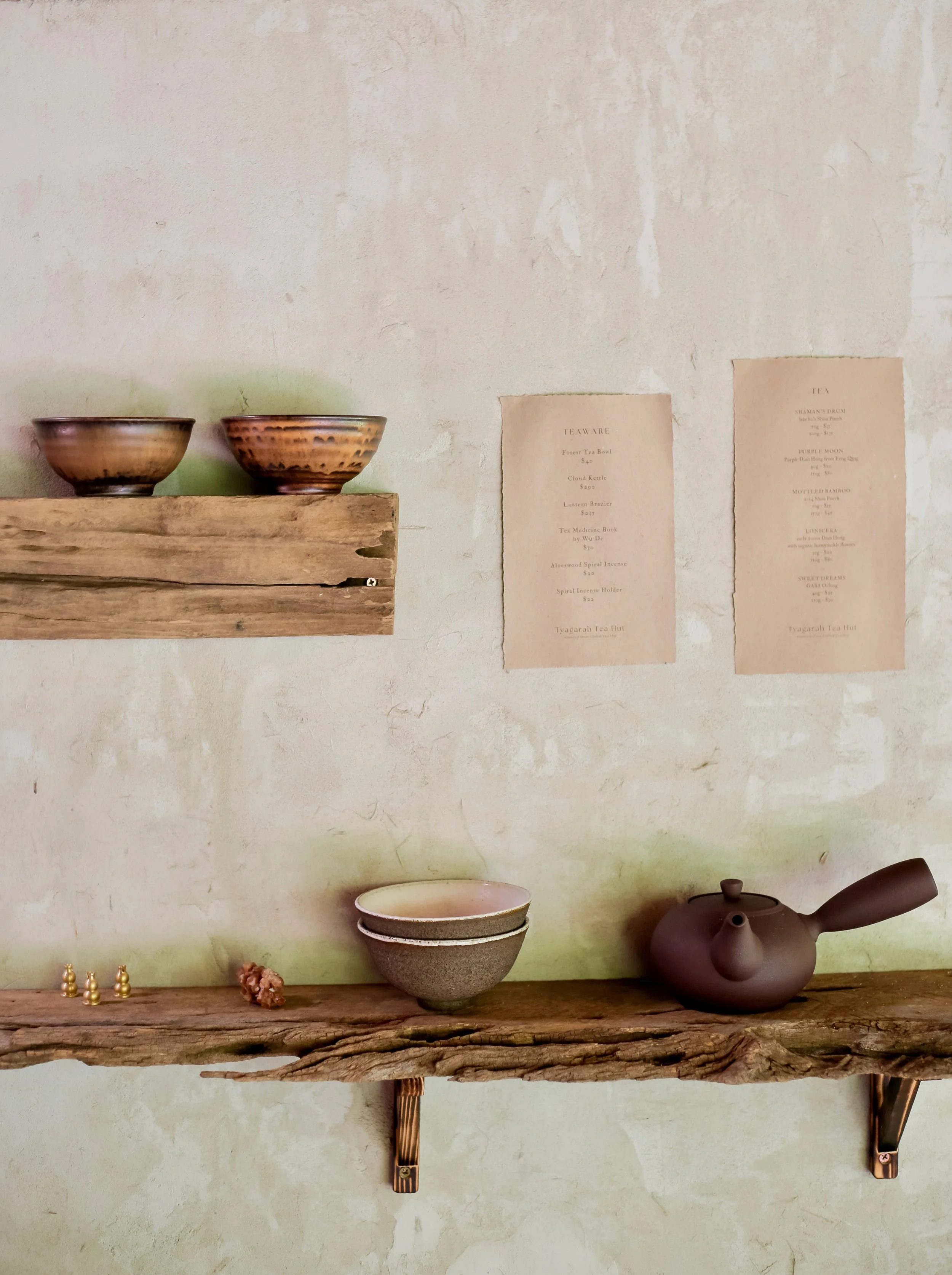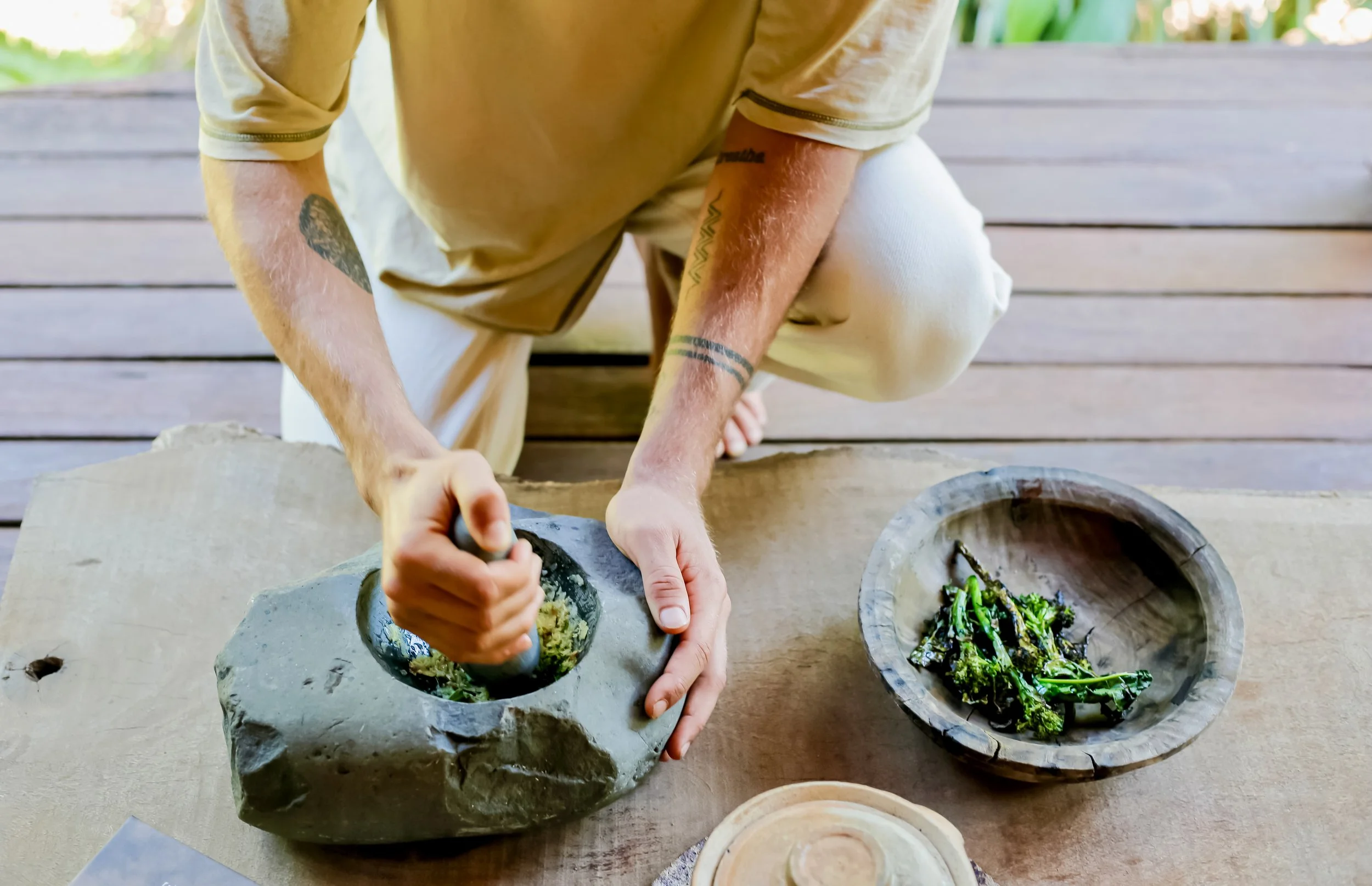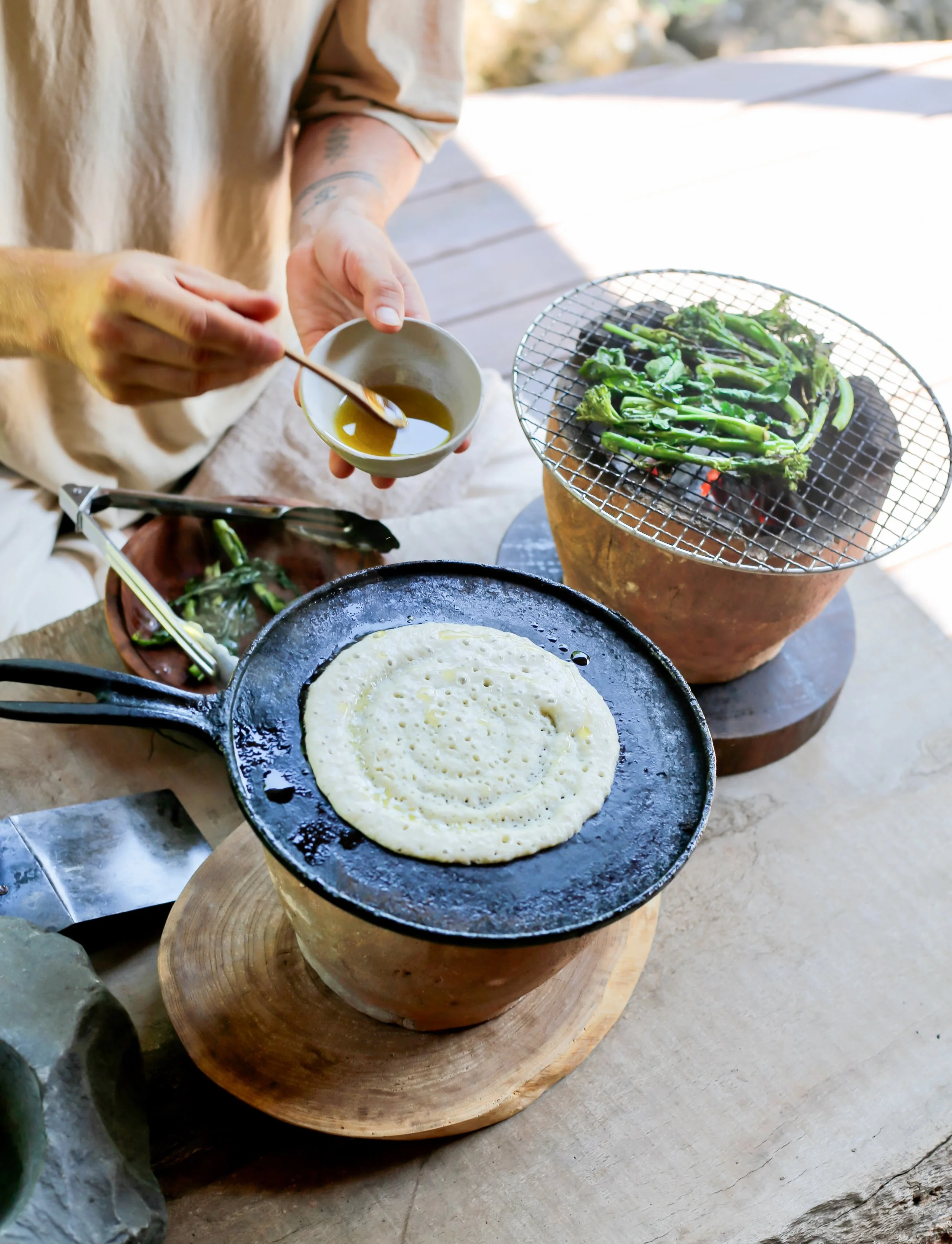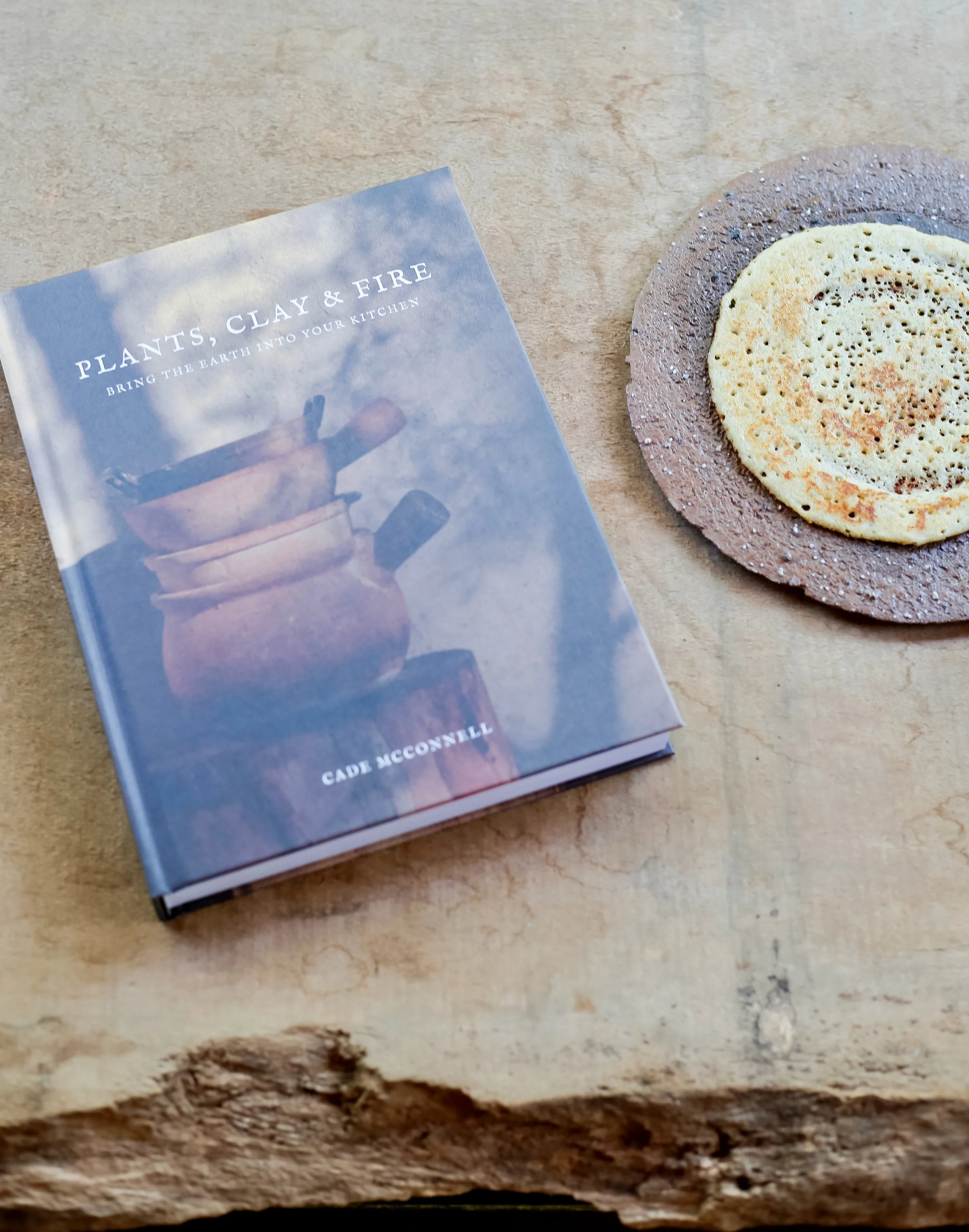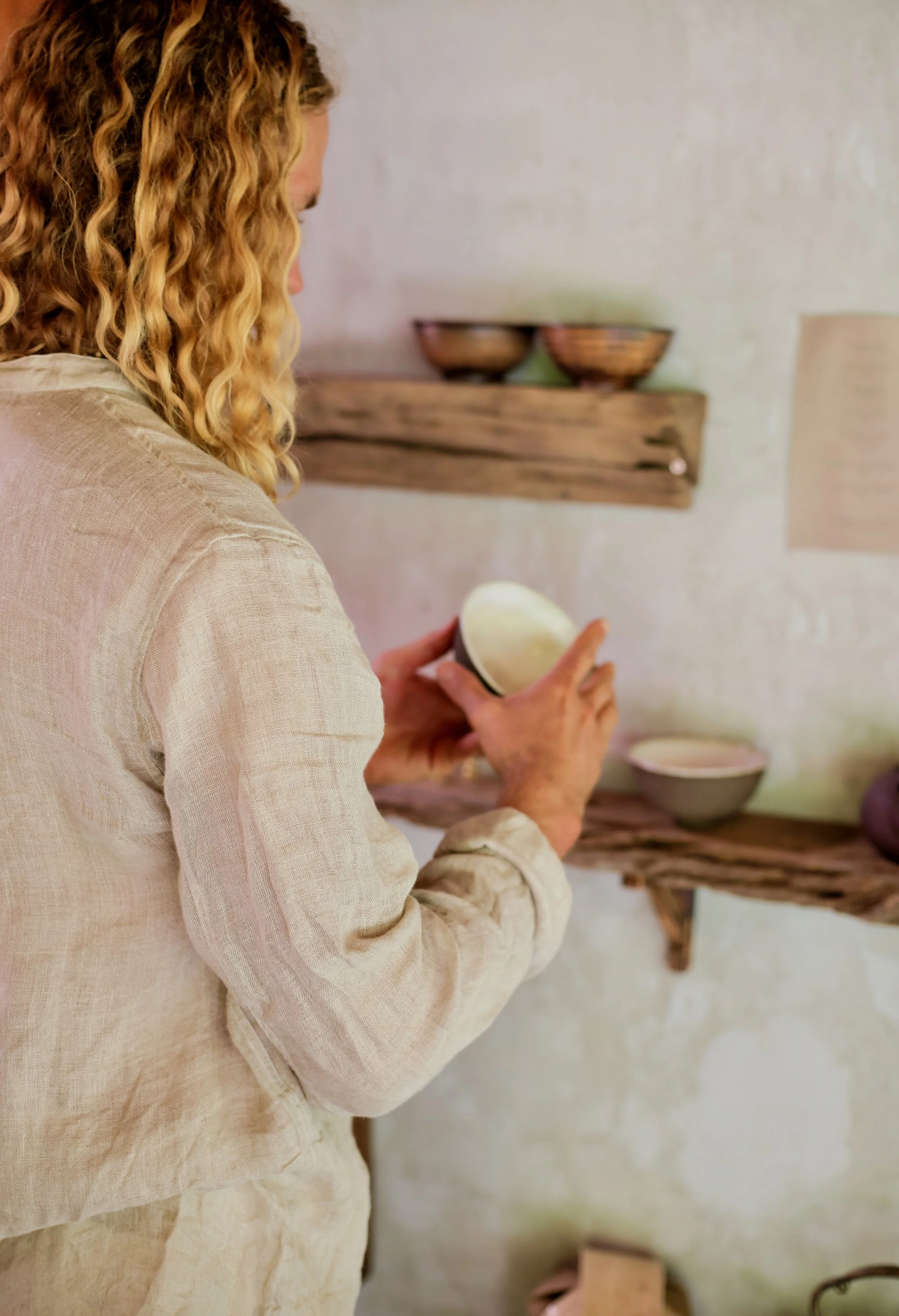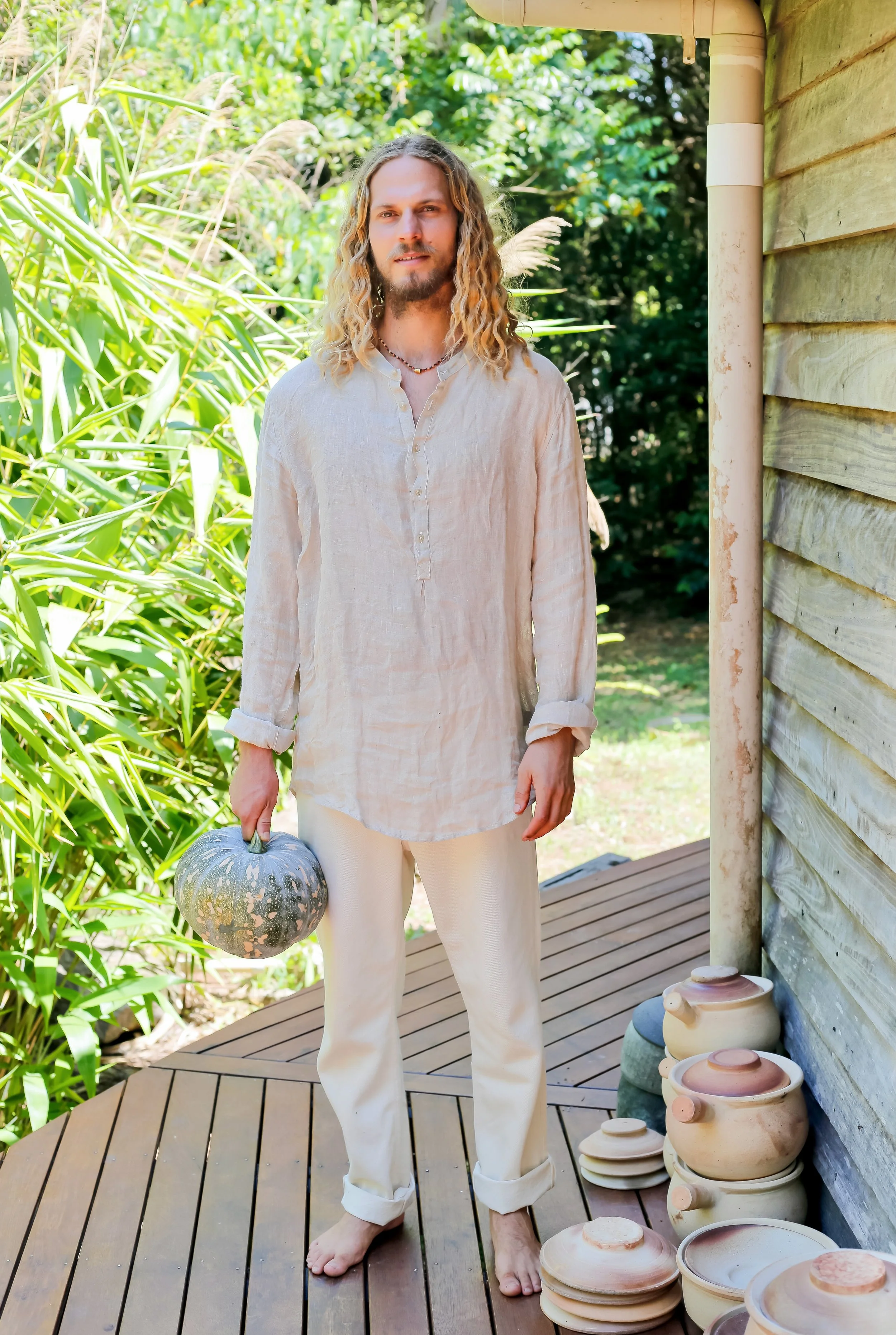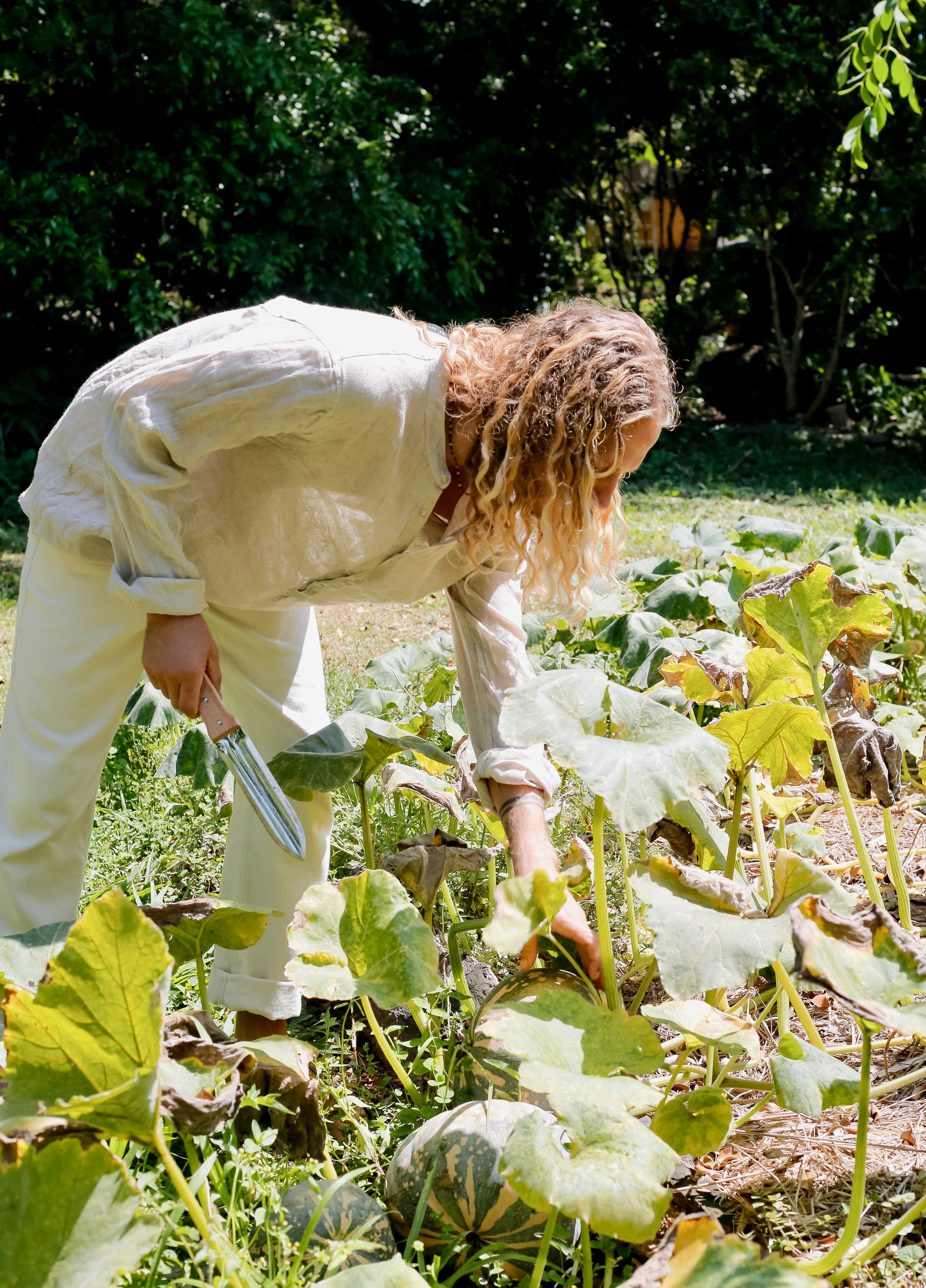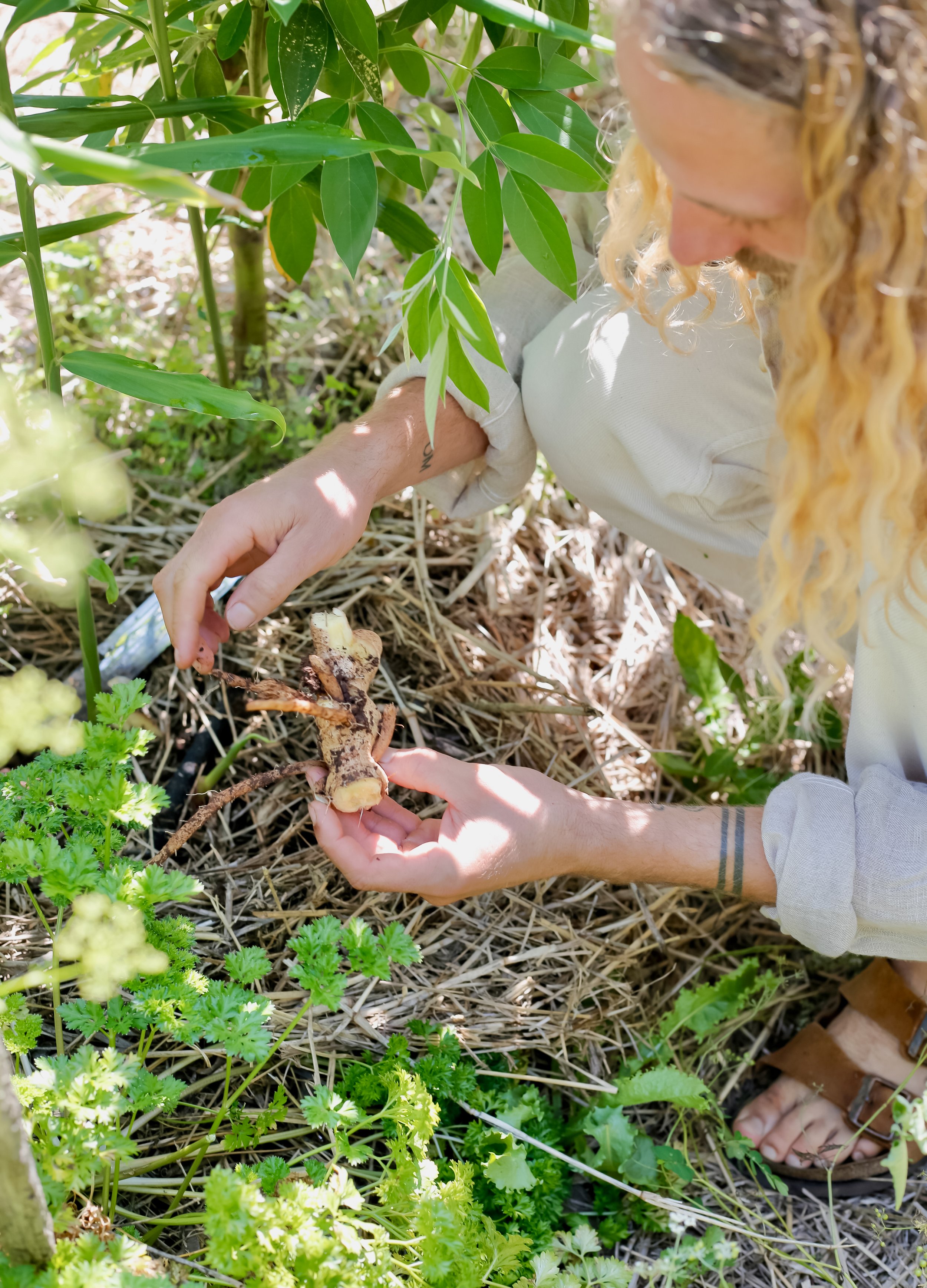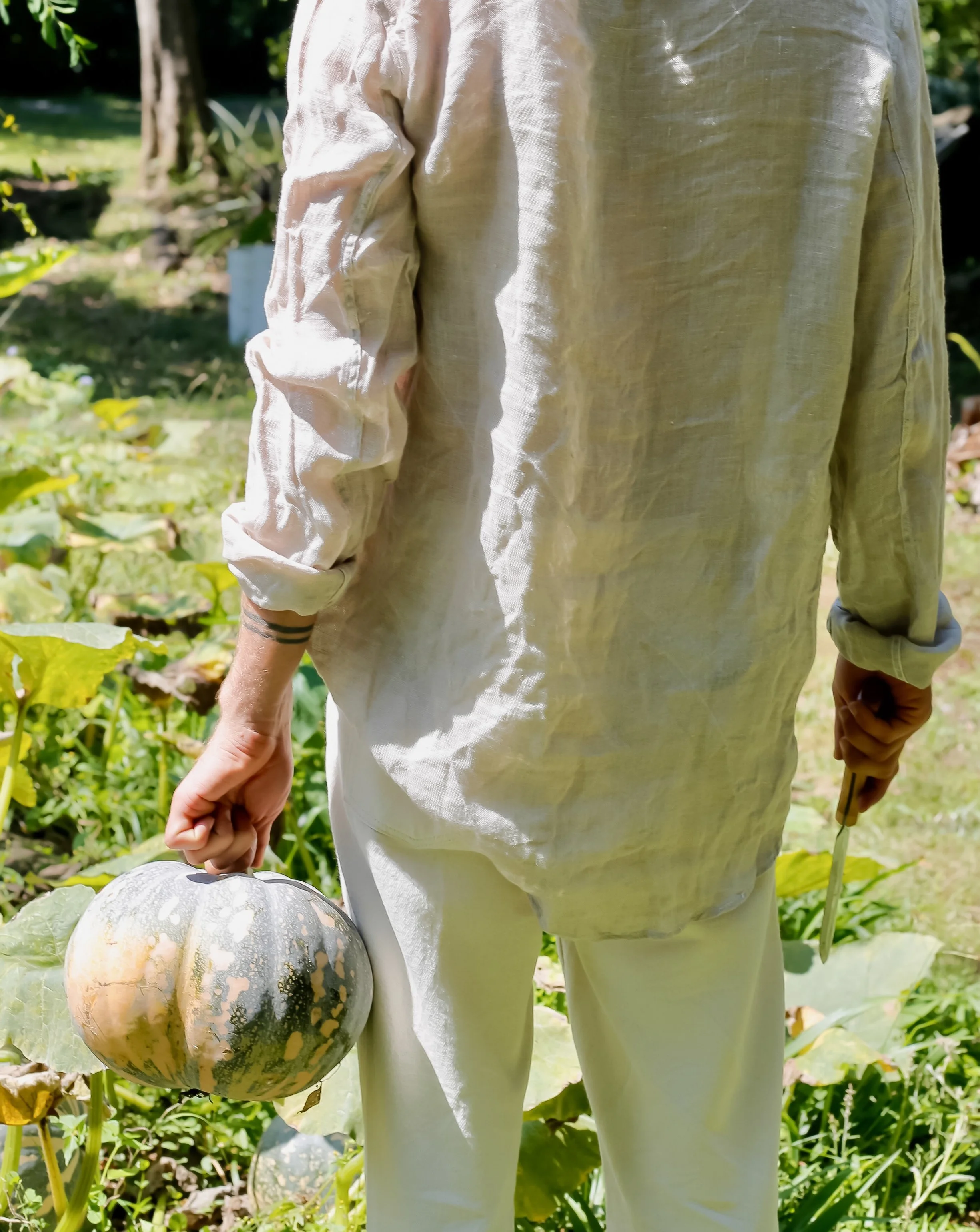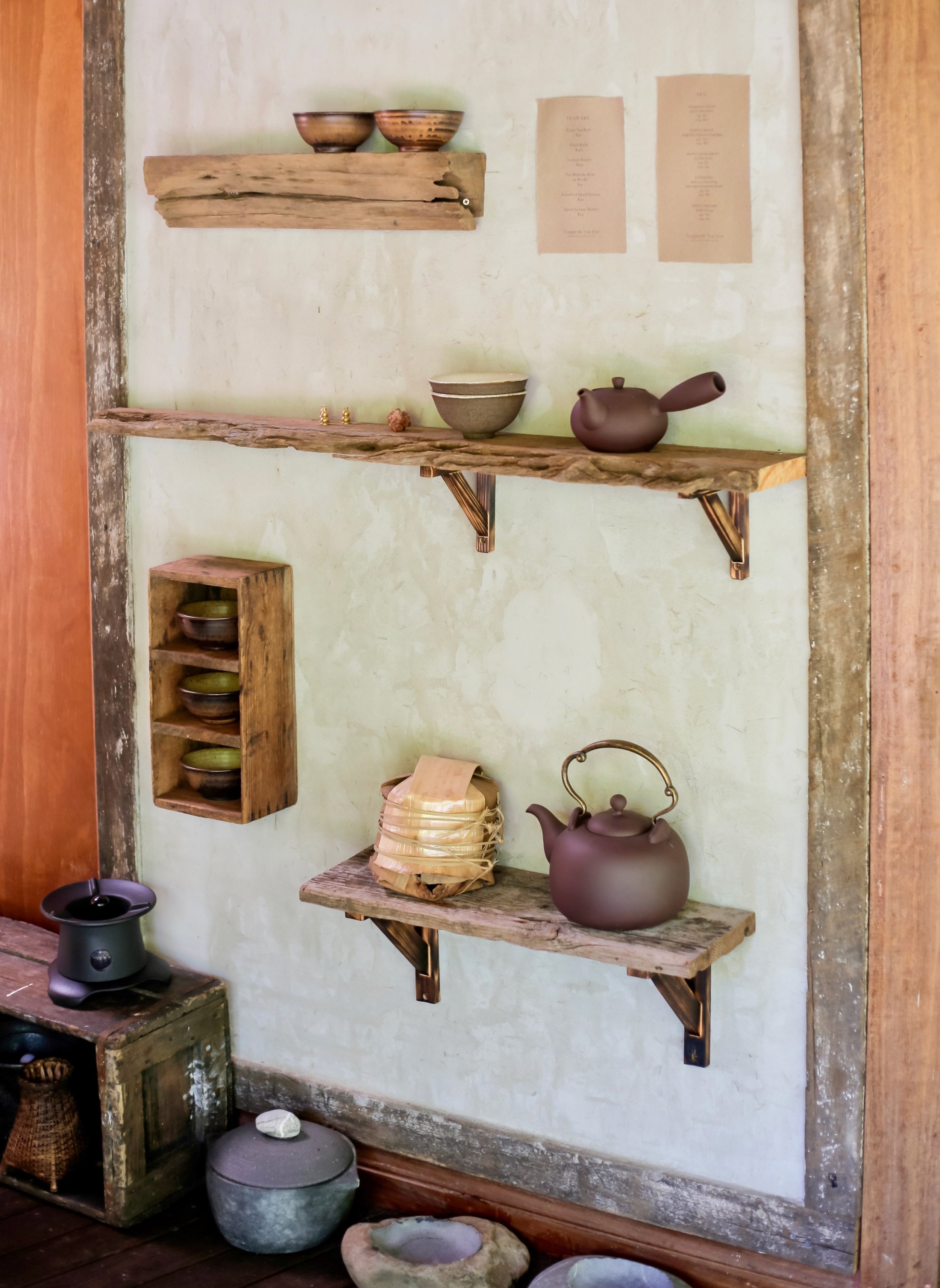Cade McConnell Values Consciousness Over Convenience
Cade McConnell’s new cookbook, Plants, Clay & Fire, embraces the simplicity and healing power of harvesting, preparing and sharing food — highlighting the importance of wholesome produce and the vital part it plays in his incredibly mindful practice.
Words: Hande Renshaw I Photography: Hande Renshaw & Nicholas Hannah
‘Food carries energy. Our state of mind and being when we are cooking is in the food, whether we like it or not.’ Photo: Hande Renshaw
Preparing a plain dosa – the dosa is a South Indian fermented pancake made from urad dal and rice. Photo: Hande Renshaw
Plants, Clay & Fire, by Cade McConnell, is available to purchase online here. Photo: Hande Renshaw
‘I am aware that my state of being when I am cooking is going into the food, hence I practice being calm and present.’ Photo: Hande Renshaw
‘Food can be medicine or poison, we make the choice. What are we eating and where does it come from?’ Photo: Hande Renshaw
Cade McConnell believes that cooking and eating are sacred tasks, and an equally essential and honourable part of each day. His mindful cooking and catering practice has been influenced by his time spent travelling to Sri Lanka, Nepal and India - places that have etched their traditions and methods into his cooking and also his new cookbook, Plants, Clay & Fire.
‘During my time in these countries, I witnessed how home-cooked food is woven within the culture, especially in the villages. The food they cook is made from wholefoods, prepared and cooked from scratch with ingredients that are local and in season – it takes time and is prepared with presence and care. This is something I practice,’ he shares.
The passion for conscious food preparation was first ignited when Cade was nineteen and exposed to cooking with spices in Sri Lanka on a trip with his older brother. It was there, at an authentic vegetarian cooking class where they cooked different curries and chutneys, that Cade’s mind was opened to the possibility of cooking beyond ingredients picked up from a grocery store. Instead, he was shown how meals can be prepared from home-grown produce, freshly picked and mindfully made into a nourishing meal to share.
‘We cooked four different curries and a couple of chutneys… we made the coconut milk fresh and smashed the curry paste in a wooden mortar and pestle. The family who hosted the class grew all of the vegetables and most of the spices on their property. I was amazed,’ says Cade. ‘The ingredients were spread out on the table, everything was pure, nothing packaged or in plastic. It shocked me into realising that this is how I wanted to cook and live.’
Today, Cade lives in the Byron Shire, on Bundjalung Country, with his wife, Samantha – a place he feels most ‘at home’, fortunate to be able to jump into the ocean each day and a place that’s also close to his friends.
‘My friends are mostly artists, who have created their own reality, their own work and are doing life their way. It’s inspiring,’ he says, ‘I love that normal here is weird elsewhere! My house is 3 wooden octagonal dwellings with a circular wooden deck around them – we shower under the stars and our toilet doesn’t flush, instead our waste turns to compost. We have a big garden, we’re surrounded by bush and see wild animals every day.’
His incredibly self-sufficient home is truly magical —I was lucky enough to visit to photograph Cade for this feature— the indoors and outdoors are connected, so that you are always at one with nature. ‘I love the spirit of this place: the ocean, forests, hills, people. There’s a joy that emanates from people here. It’s a special place and is evident why it attracts people from all over the world. I am blessed to be here.’
Plants, Clay & Fire truly embraces the philosophy of traditional teachings and methods that Cade has picked up along the years. From the empowering practice of growing his own food, to the kitchen cooking tools he uses to prepare meals, made from either clay, stone, wood and metal, influenced from villages he’s visited.
The recipes within the cookbook tune into the healing power of food and the energy we transfer when we’re preparing a meal. ‘Presence is healing, touch is healing. We know this. We can feel when a loved one isn’t present with us and we know the feeling of being held in loving arms,’ says Cade, ‘Food carries energy. Our state of mind and being when we are cooking is in the food, whether we like it or not. This is why I speak of the importance of using our hands when we are preparing food. Touch it. Try dressing a salad with your hands or smashing an avocado between your fingers. Our hands are the original utensils.’
We share a recipe from the new cookbook below – Satay Chocolate.
‘Plants, Clay & Fire’ is available to purchase online here.
‘Artisans all over the world always created tools and utensils from resources that were nearby. I am inspired by this and do my best to support the local craftspeople of my area and also others from around the world.’ Photo: Hande Renshaw
‘For me, growing food is an educational and enriching practice. It’s empowering knowing I am capable of growing my own food and not needing to be fully reliant on the food system. It connects me to the land where I live.’ Photo: Hande Renshaw
‘Being in the garden means observing nature and her changes. It means problem solving and improvising. Like cooking, growing food requires our presence, care and time.’ Photo: Hande Renshaw
‘I realised that eating organic wholefoods, prepared and cooked with care made me feel great and alive more than ever. It was one big piece for me to be living in integrity.’ Photo: Hande Renshaw
“Food carries energy. Our state of mind and being when we are cooking is in the food, whether we like it or not. This is why I speak of the importance of using our hands when we are preparing food. Touch it. Try dressing a salad with your hands or smashing an avocado between your fingers.”
‘There’s a feeling when I cook in clay that’s hard to articulate – it just feels right.’ Photo: Hande Renshaw
Cade McConnell’s beautiful clay Village Pots are made in villages in Colombia and Malaysia. Photo: Hande Renshaw
Satay Chocolate from Cade McConnell’s new cookbook, Plants, Clay & Fire – recipe shared below. Photo: Nicholas Hannah
‘Artisans all over the world always created tools and utensils from resources that were nearby. I am inspired by this and do my best to support the local craftspeople of my area and also others from around the world.’ Photo: Hande Renshaw
SATAY CHOCOLATE
Sounds strange, but it works. I was buying lime leaves and lemongrass from a farmer at the markets. She asked what I was using them for and I responded for curry and in coconut rice. She told me that she puts them in her homemade chocolate and to give it a try. I did, and this is the recipe I came up with. You don’t have to add the lemongrass, as it can be fiddly, but it’s worth it!
Serves 8 to 12
Prep time 15 to 20 minutes | Setting time - 1 hour +
Special equipment Chocolate moulds
INGREDIENTS
2 lime leaves, spine removed
1 tsp lemongrass, the white flesh from the centre of the base (optional) 2 tsp fresh ginger
1 cup cacao butter
1/2 cup raw cacao powder
2.5 tbsp coconut sugar
2.5 tbsp maple syrup
1 tbsp roasted peanut butter
1 tsp vanilla extract (optional)
a pinch of salt
3/4 cup coconut shreds, toasted
METHOD
In a mortar and pestle, pound the lime leaves, lemongrass and ginger into a paste. Alternatively, you can finely grate the ginger and very finely chop the limes leaves and lemongrass. Set aside in a medium sized stainless steel bowl.
Pour boiling water into a saucepan and place it on a low heat on the stovetop. Put the stainless steel bowl with the lime leaves, lemongrass and ginger on top of the saucepan (as a double boiler). Add the cacao butter and let it melt into a liquid. Once melted, add all other ingredients and whisk to combine evenly. Turn the heat off.
Line a baking tray with parchment paper if you don’t have chocolate moulds. Remove the bowl from the saucepan and wipe off any moisture from the bottom with a kitchen towel. Be careful as the bowl will be hot. Using a spatula, pour and scrape the mixture into the tray or chocolate moulds.
Place this chocolate in the fridge for a couple of hours to set. When it has set, cut it into rustic pieces or remove it from the moulds and store in an airtight container in the fridge until you’ve eaten it all.
NOTE: Set your chocolate in a dish appropriate to how you like it. If you like thick pieces, use a narrower dish and for a thinner chocolate use a wide baking dish. The more you make this recipe, the more you’ll understand how you like it! If you have a peanut allergy, use almond or macadamia butter instead.



